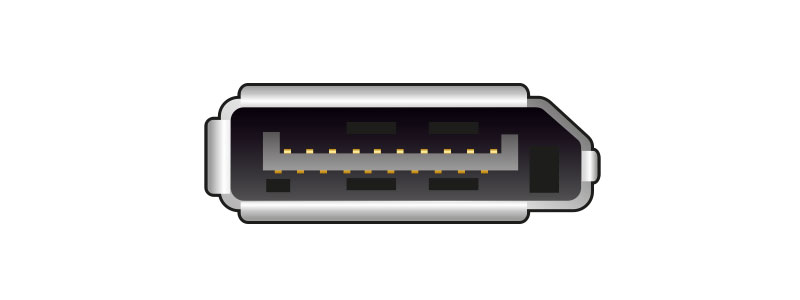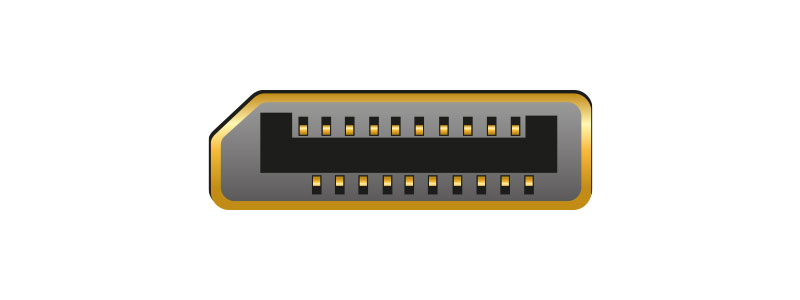In this article:
- What is DisplayPort and how is it used?
- What is Dual Mode HDMI, and how does it differ from DisplayPort?
- What is Mini DisplayPort, and how does it compare to DisplayPort?
What is DisplayPort and how is it used?


FEMALE MALE
DisplayPort is a digital display interface primarily utilised for linking video sources like computers, laptops, and gaming consoles to monitors, TVs, and projectors. It’s designed to transmit high-definition video and audio signals, along with data, via a single cable.
What are the different types of DisplayPort connectors available?
DisplayPort connectors come in various sizes, including the standard DisplayPort, Mini DisplayPort, and USB Type-C with DisplayPort Alt Mode.
What features make DisplayPort versatile?
DisplayPort is renowned for its versatility, supporting a range of display resolutions, refresh rates, and color depths, including 4K, 5K, and even 8K resolutions. It also offers features like multi-stream transport (MST) for daisy-chaining multiple displays and adaptive sync technologies such as AMD FreeSync and NVIDIA G-SYNC for smoother gaming experiences.
How far can DisplayPort cables transmit signals?
DisplayPort cables can typically transmit signals over relatively long distances without significant degradation, making them suitable for both desktop setups and professional display installations.
What are the typical cable runs for DisplayPort connections?
For desktop setups and office environments, typical cable runs range from 3 to 15 feet (1 to 5 meters), connecting computers, laptops, or docking stations to monitors or display hubs.
How about professional display installations?
In professional display installations like conference rooms or digital signage setups, longer cable runs may be needed. DisplayPort cables can transmit signals over distances ranging from 15 to 50 feet (5 to 15 meters) or even longer, depending on the version of DisplayPort and cable quality.
What considerations are there for longer cable runs?
Longer cable runs may require active DisplayPort cables or signal boosters to maintain signal integrity. Factors like cable quality, electromagnetic interference, and display resolution can also affect the maximum cable length supported.
What is Dual Mode HDMI, and how does it differ from DisplayPort?

FEMALE
While “Dual-port HDMI” isn’t a standard term, HDMI ports can support Dual Mode, enabling them to output HDMI signals or DisplayPort signals with the aid of an adapter or compatible cable. DisplayPort, on the other hand, is a digital display interface primarily used for connecting various video sources to monitors, TVs, and projectors, offering additional features such as higher bandwidth and support for higher resolutions and refresh rates.
What are the typical cable runs for HDMI and DisplayPort connections?
Typical cable runs for both HDMI and DisplayPort connections vary based on the display setup and interface version. For desktop setups and home entertainment systems, cables usually range from 3 to 15 feet (1 to 5 meters), connecting computers, gaming consoles, Blu-ray players, and other devices to TVs, monitors, or AV receivers.
What about professional display installations?
In professional setups like conference rooms or digital signage installations, longer cable runs may be necessary to connect display sources to remote displays or projectors. HDMI and DisplayPort cables can typically transmit signals over distances ranging from 15 to 50 feet (5 to 15 meters) or even longer, depending on cable quality and interface version.
What considerations are there for longer cable runs?
Longer cable runs may require active HDMI or DisplayPort cables, signal boosters, or fiber optic cables to maintain signal integrity. Factors like cable quality, electromagnetic interference, and display resolution can impact the maximum cable length supported in a given setup.
What is Mini DisplayPort, and how does it compare to DisplayPort?


FEMALE MALE
Mini DisplayPort, often abbreviated as Mini DP or mDP, is a smaller version of the DisplayPort interface, serving the same purpose as DisplayPort. It is primarily used for connecting laptops, tablets, and desktop computers to monitors, projectors, and other display devices. Mini DisplayPort offers similar features and capabilities to DisplayPort, including high-definition video and audio transmission, support for high resolutions and refresh rates, and compatibility with various display technologies.
What are the typical cable runs for Mini DisplayPort connections?
Typical cable runs for Mini DisplayPort connections are similar to those for DisplayPort connections and can vary based on the display setup and interface version. For desktop setups and office environments, cable runs typically range from 3 to 15 feet (1 to 5 meters), connecting laptops or desktop computers equipped with Mini DisplayPort outputs to monitors or display hubs on a desk or workstation.
How about professional display installations or home entertainment systems?
In professional setups or home entertainment systems, longer cable runs may be necessary to connect Mini DisplayPort sources to remote displays or projectors. Mini DisplayPort cables can transmit signals over distances ranging from 15 to 50 feet (5 to 15 meters) or even longer, depending on cable quality and interface version.
What considerations are important for longer cable runs?
Longer cable runs for Mini DisplayPort connections may require active cables, signal boosters, or fiber optic cables to maintain signal integrity and prevent signal degradation over extended distances. Factors like cable quality, electromagnetic interference, and display resolution can also affect the maximum cable length supported in a given setup.